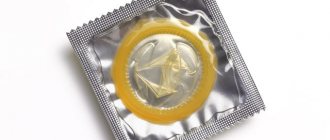In the modern world, there is a great choice of everything and everyone, including contraceptives. Moreover, each manufacturer praises its means of protection, usually emphasizing only the advantages and keeping silent about the disadvantages.
It is quite difficult to independently understand such a flow of diverse and sometimes contradictory information, but in this article we will try to objectively highlight all the pros and cons of the main means of contraception.
To begin with, it is worth noting that there are quite a few methods of contraception, but only 2 of them are used for long-term protection against pregnancy: intrauterine devices and hormonal contraceptives .
How contraceptive methods work
The contraceptive effect of hormonal pills is based on preventing ovulation, which is why the maturation of the egg does not stop and pregnancy does not occur. The cervical mucus also thickens, and this prevents sperm from penetrating into its cavity.
The spiral, being inside the uterus, causes a reaction in its inner layer, which consists in the rejection of the fertilized egg. This changes the peristalsis of the fallopian tubes and the ability of sperm to pass through the uterine cavity.
What else should you consider?
All of the previously mentioned hormone-free alternatives are also possible for menstruation-related migraines without aura.
If a headache first attacks the use of the tablet, possibly with neurological symptoms, the drug should be discontinued in any case, as well as neurological and possibly ophthalmological relief. Smoking increases headaches and migraines and significantly increases the risk of stroke. We can urgently appeal to all women to quit smoking. Of course, we would be happy to advise you in a personal conversation. Small pieces of plastic that release hormones and, as an alternative to the pill, prevent pregnancy in this way, have been around for a long time: like rods in the upper arm or hormonal coils. In February, a plastic ring appears on the market in preparation for the pill and cat competition.
Operating principle
The action of the spirals is aimed at preventing the fertilization of the egg. Acting as a kind of foreign body, the contraceptive accelerates several times the passage of a fertilized egg through the fallopian tubes into the uterus, without achieving its full maturation. In addition, the spiral does not allow the embryo, even in the case of fertilization, to be implanted into the uterine mucosa.
The inclusion of certain materials or hormonal drugs in the IUD, in addition, significantly weakens the activity of sperm and creates a mucous plug in the cervix, preventing their penetration inside.
The spiral can stimulate the occurrence of artificial aseptic inflammation of the endometrium, which is not dangerous to the woman’s health, but disrupts the process of ovulation and fertilization.
Advantages and disadvantages of contraceptives
Pros of using hormonal contraceptives
- Protects against pregnancy by 98-99.7%.
- Regulates the menstrual cycle, making menstrual periods painless and with less blood loss.
- Starting to use the method does not require medical intervention.
- You can stop using the method yourself at any time.
- The duration of use of the tablets is not limited.
- Improves skin condition.
- Reduce the risk of endometriosis and cancer of the genital area.
- Prevents ectopic pregnancy.
Advantages of the spiral
It is four millimeters narrow and elastic. It is based on the hormones ethinyl estradiol and etonogestrel, which penetrate into the blood through the vaginal mucosa and suppress ovulation. Not only is daily memory eliminated, but also the defense against vomiting is reduced. A woman can use it like a tampon after squeezing the ring with her fingers.
After three weeks of wearing it, it is removed, followed by a non-recoverable week in which bleeding occurs. Direct delivery into the bloodstream requires fewer hormones, especially in terms of estrogen content. Side effects such as nausea, breast tenderness and headache were lower, and bleeding disorders were 4.4 percent lower than what happens with the pill. Five percent of study participants experienced mild vaginal irritation and breakdown. In terms of safety, the ring is right up there with modern micropillars.
- Contraceptive effectiveness is 99.4%.
- Long-term prevention of unwanted pregnancy (up to 5 years).
- Does not interact with medications.
- There is no systemic effect on the body.
- No need to buy every month.
- Relatively cheap.
Negative aspects of using hormonal contraceptives
- The need to take pills daily.
- Possibility of temporary side effects (nausea, heaviness in the mammary glands, spotting), which disappear after 60-90 days.
- Increased risk of thrombosis and complications associated with this pathology.
- Changes in mood and sex drive.
- Fluctuations in body weight.
Disadvantages of using a spiral
- Only a doctor in a medical facility can administer and remove the product.
- Every month you need to independently monitor the spiral threads.
- During the first months of use, increased menstrual bleeding may occur.
- The spiral may fall out on its own.
- The risk of ectopic pregnancy and complications in case of infection with sexually transmitted infections increases.
What is better to choose and what to pay attention to?
Before deciding whether an intrauterine device or pills is better, a woman should consult her gynecologist . During a medical consultation, a specialist will select the best option for protection against unwanted pregnancy, taking into account the following factors:
- Patient's age.
- The presence of concomitant diseases in chronic and acute form.
- The condition of the woman’s reproductive system, the regularity of the ovarian-menstrual cycle and previous surgical interventions, including abortions.
- Regularity of sexual activity.
If we are talking about nulliparous patients, then they rarely have an intrauterine device installed, preferring to prescribe oral contraceptives. The reason for this is the high risk of developing deforming changes in the uterine area under the influence of a foreign body. If a married couple already has children and plans a new pregnancy no earlier than in 3-4 years, then intrauterine contraception is the best option.
Important! Both contraceptive options are only suitable for women who have regular sex life with the same partner. When changing partners, it is recommended to take care of protection from infection with sexually transmitted diseases. For this purpose, it is recommended to use barrier methods of protection.
Contraindications to the use of methods
In terms of ease of use and wear, the ring has received good marks so far, with only a few women saying they felt it in intimate situations, and slightly more likely to report it to their partners. It is possible to remove the ring for a short time. But then you have to remember to use it again after three hours. “Nuvaring is a good method for women who do not want to think about pills every day and have an irregular rhythm of life,” sums up gynecologist Carmen Jacobi from Hannover, along with her impressions.
In a retrospective of contraceptive innovation in recent years, she comes to very different assessments. This will be somewhat of a rather high price around 350 euros. But this also often led to the detection and disruption of the cycle by the progestogen containing the rod. Bleeding problems like these often trigger a three-month injection.
Hormonal contraceptives cannot be used by nursing mothers, women with bleeding disorders, thrombosis, severe liver disease, or breast cancer.
The IUD should not be placed in women with genital tract infections, congenital anomalies or benign tumors of the uterus, with tuberculosis of the pelvic organs and with diseases of the heart valves in the active phase.
And since re-ovulation may be delayed here after stopping, this route is more likely to be something for older women who already have children. So the pure Mirena IUD is much better: "Satisfaction is very high, women have less bleeding, sometimes none and they are rated as very positive that you have to think about anything." Unlike all other methods mentioned, the hormone acts only directly in the uterus and does not play a significant role in blood circulation. However, those who are still looking for another method: the next drug is already a hormonal spot this year for approval.
Spirals in nature
In nature, there are approximations to logarithmic spirals with a growth coefficient equal to φk. Thus, the shells of the mollusks Nautilus pompilius and fossilized ammonites are well described at k = 2, and the shells of some snails at k = 1. The ratio of the lengths of three turns of the spiral of the human ear is φ, which corresponds to a spiral with k = 1. The arms of spiral galaxies, despite existing statements, if described by a logarithmic, are not a golden spiral. In this case, her description is a manifestation of accidental proximity. A recent analysis of the helices found in the corneal epithelium of mice showed that both golden and other logarithmic helices occur there.
Rules for the use of contraceptives
The IUD can only be inserted by a doctor; you just need to periodically monitor the position of its threads and remember to visit a specialist when the contraceptive expires. Regarding the insertion of the IUD, you need to contact your gynecologist in the first 12 days after the start of menstruation. It is also possible to start using the product on any day of your cycle that is convenient for you, if you know for sure that you are not pregnant.
Danish study: Hormones in contraceptives such as the pill and IUD easily increase the risk of breast cancer. It's a small but statistically significant difference, which Danish scientists report to Lina Mørch of the University of Copenhagen in the New England Journal of Medicine. However, the result is confirmed by the abundance of analyzed data: the fates of 1.8 million Danes, aged 15-49 at the beginning, were observed for almost eleven years.
The risk has already emerged in small studies
Review of various contraceptives
You have a new partner. Then it is logical that you are dealing with contraceptives. What form of contraception do you choose? The supply is incredibly large, which doesn't make it any easier. Pill, coil or natural method? The pill contains hormones that prevent ovulation and make the uterus unsuitable for pregnancy. Thus, no fertilization can take place. There are tablets containing both estrogens and progestins. There are also single progestins.
The effectiveness of birth control pills directly depends on their regular use. You will need to take one tablet at approximately the same time every day. Forgetfulness in this case can lead to an unwanted pregnancy.
The first tablet from a package containing 21 tablets is taken on the first day of menstruation and continued until the end of the blister. Then they take a week-long break, during which menstruation occurs, and begin the next pack. If the blister contains 28 tablets, then after it runs out, immediately start a new one.
In most cases, you take the pill for three weeks and then take a week off. During this break week you get your period. There are also pills that need to be taken continuously. In this case, there is no break week, but most often bleeding occurs in the fourth week of the cycle.
Advantages of the pill: easy to use, very reliable, gives predictable and easy periods. With most pills, you can also move your periods around easily. Disadvantages of the pill: It must be taken daily and contains hormones that can cause side effects.
Instructions for using the vaginal ring
The protective properties of the vaginal ring are based on the activity of etonogestrel, a progestogen derivative, and ethinyl estradiol. The latter is an estrogen widely used in contraceptives. The main effect of the ring is based on inhibition of ovulation.
How to use the Nuvaring birth control ring?
- The ring is inserted into the vagina in a position convenient for this.
- From the moment of insertion, the ring should remain inside the vagina for three weeks.
- After three weeks, the ring must be removed and menstruation will begin.
- After a week's break, a new Nuvaring ring is introduced.
If menstruation does not end on the fifth day, the ring must still be inserted into the vagina on the 5th day of the cycle.
After childbirth or abortion, the ring can be used as a contraceptive in the fourth week.
Contraindications to the use of the ring are the following diseases of a woman:
- vein thrombosis
- predisposition to blood clots
- diabetes
- vaginal bleeding of unknown cause
- malignant tumors
- pancreatitis
- allergic reaction to the components of the drug
- pregnancy
- lactation
- ulcerative colitis
- smoking over the age of 35
- chronic constipation
It is necessary to insert the ring into the vagina as quickly as possible.
Before using a vaginal ring for pregnancy, it is recommended to consult your gynecologist and make sure that it is advisable to use this type of contraception. In order to ensure the proper level of protection, it is necessary to insert a contraceptive uterine ring between days 1 and 5 of the ovarian-menstrual cycle.
First of all, a woman needs to thoroughly wash her hands with soap, remove the contraceptive from the package, and then sit on the edge of a chair with her legs wide apart. Using the index and middle fingers, the ring is inserted until it comes into firm contact with the cervix.
The contraceptive effect of one hormonal contraceptive ring is designed for one full menstrual cycle. It is necessary to remove the product on the 22nd day of the cycle, after which the woman should take a break of 1 week, and on the 8th day a new ring should be inserted.
If a woman is faced with the loss of an intrauterine contraceptive ring, then she needs to determine the time that has passed since the spontaneous removal of the contraceptive. If this period does not exceed 3 hours, then the product must be washed under running water and reinserted into the vagina.
We suggest you read: How to strengthen potency with folk remedies
During the period of bearing a child and breastfeeding, the use of a contraceptive gynecological ring is strictly contraindicated.
After an abortion
If induced termination of pregnancy through abortion was carried out at less than 12 weeks, then the installation of a ring against unplanned pregnancy can be performed immediately.
Which contraceptive method should you choose?
First, contact a competent gynecologist with this question. The doctor knows what features of the use of contraceptives you should pay attention to in your case. It would be useful to undergo an examination before starting to use the method.
Rules for the use of contraceptives
The IUD is a small, anchored object that is inserted into the uterus.
There are two types: copper IUDs and hormonal IUDs. The copper coil works without hormones. Copper wire makes sperm inactive and thus prevents pregnancy. The hormonal IUD operates on the basis of gestagen. A small amount of this hormone is constantly released into the uterine cavity. The IUD provides protection against pregnancy for five to ten years. The benefits of the IUD: You don't have to think about contraception for years. The copper coil also does not contain hormones. Disadvantages of the IUD: Insertion of the IUD can be painful and must be performed by a physician. With the help of the IUD, menstruation cannot be delayed. In addition, the period may be irregular or absent.
Secondly, according to reviews from women who have tried both the hormonal method of contraception and the IUD, there is no clear opinion about which method was the best. Supporters of hormonal pills are not satisfied with the abortive mechanism of the intrauterine system and the very fact of the presence of a foreign body in the uterus.
And women using the IUD are concerned about possible side effects from hormones and the relatively high cost of the pills. This once again proves that the best method is the one that suits you.
Once in the vagina, the ring gradually releases hormones. These hormones ensure the absence of ovulation and also make the uterus unsuitable for fertilization. After three weeks you can remove the ring, followed by a week off during which time bleeding begins.
After the break week, bring a new ring. Inserting and removing the ring is also very easy. This contraceptive can be used to delay menstruation. This contraceptive works on the basis of hormones that are gradually released from the patch to the skin. The patch contains enough hormones for a week. They post a new patch every week. After three weeks there is a week off, during which bleeding begins. After this, you will apply new plaster again.
Pregnancy is not always planned and desired. Perhaps a woman already has children or she simply does not want them due to her beliefs, the reasons may be different and this is a personal matter for each adult. But which contraceptive is still better? Oral or vaginal.
The most popular types of IUDs today
Features: T-shape with levonorgestrel hormone in the shaft. The drug is “thrown out” into the uterus at a dose of 24 mcg/day. The most expensive and effective spiral. Price – 7000-10000 rub. Installation period is 5 years. The IUD helps treat endometriosis or uterine fibroids (plus), but also leads to the formation of follicular ovarian cysts.
IUD Multiload
Features: oval shape with spikes-protrusions to reduce the risk of falling out. Made from plastic with copper wire. Cost – 2000-3000 rubles. Prevents fertilization (sperm die due to the inflammatory reaction caused by copper) and implantation of the embryo (when it appears) in the uterus. It is considered an abortifacient method of contraception (as, indeed, any other IUD). Use is permitted for women who have given birth. Side effects: increased duration and pain of menstruation, pain in the lower abdomen, etc. The contraceptive effect can be reduced when taking antidepressants.
Navy Nova T Cu
Features: shape – “T”, material – plastic with copper (+ silver tip, barium sulfate, PE and iron oxide), installation period – up to 5 years, average price – about 2000 rubles. For easy removal of the spiral, the tip has a thread with 2 tails. The action of the IUD: neutralizes the ability of sperm to fertilize an egg. Disadvantages: does not exclude the possibility of an ectopic pregnancy; there are known cases of uterine perforation during installation of the IUD; it causes heavy and painful periods.
Navy T-Copper Cu 380 A
Features: shape – “T”, installation period – up to 6 years, material – flexible polyethylene with copper, barium sulfate, non-hormonal device, German manufacturer. Action: suppression of sperm activity, prevention of fertilization. Recommended for women who have given birth. Special instructions: heating of fragments of the spiral (and, accordingly, their negative impact on surrounding tissues) is possible during thermal procedures.
Navy T de Oro 375 Gold
Features: contains 99/000 gold, Spanish manufacturer, price – about 10,000 rubles, installation period – up to 5 years. Action: protection against pregnancy, reducing the risk of uterine inflammation. The shape of the IUD is a horseshoe, T or U. The most common side effects are increased intensity and duration of menstruation.
Which is better, the IUD or birth control pills?
If a woman categorically does not want to have more children, she should take precautions and not forget that pregnancy is not having a kitten, you will have to answer for it.
This means that the process of sexual activity should be controlled not only with the mind, but also with the help of medicine. Spiral.
This is a special device that consists of copper and plastic (more expensive models are made of titanium and silicone). It is T-shaped, and is installed 5-6 days after menstruation. It prevents the fertilized egg from attaching to the wall of the uterus, reduces the viability of the egg, and also prevents the movement of the zygote along the walls of the uterus. You can clarify that it is possible to get pregnant with the IUD, but this is one case out of a hundred. Therefore, this method of protection is quite reliable, except for the presence of a foreign body inside the body, and besides, doctors say that after removing the IUD, a woman cannot become pregnant for a very long time, since the vital activity of the egg is very low.
Oral contraceptives.
These are ordinary tablets that have a hormonal composition. Its functions include:
Benefits of a hormonal patch: You don't have to think about contraception for a whole week. With the help of plaster, menstruation can be easily turned off or postponed. Disadvantages of Hormonal Patch: The patch contains hormones that can cause side effects. Additionally, the patch can sometimes lose its adhesive ability, causing it to fall off.
Types of intrauterine devices
The contraceptive device comes in several types. Depending on the shape, T-shaped, ring-shaped and other IUDs are distinguished. In addition, they may differ in elasticity and rigidity. This depends on the material from which the spiral is made. IUDs are divided into 2 large groups: plastic and metal intrauterine devices. The former only cause an immune reaction of the endometrium and block implantation. The latter have a spermicidal effect. The metal most often used is copper. In addition, there are hormonal IUDs that contain progesterone. This substance prevents the onset of ovulation and also reduces pain during menstruation.
Advantages of intrauterine contraception
The use of intrauterine contraception is chosen by many women around the world. Why is the contraceptive device so widely used? Price is one of the criteria by which women choose a contraceptive. The IUD is one of the cheapest methods of birth control. Other advantages of intrauterine devices include:
- Ease of use. The IUD is completely invisible not only to the partner, but also to the woman herself, so she does not remind of herself in any way for several years. In addition, if you want to have a child, the IUD can be removed at any time.
- Reliability - modern IUDs have several mechanisms that provide a contraceptive effect.
- Long lasting.
- No side effects that are inevitable when taking hormonal drugs.











